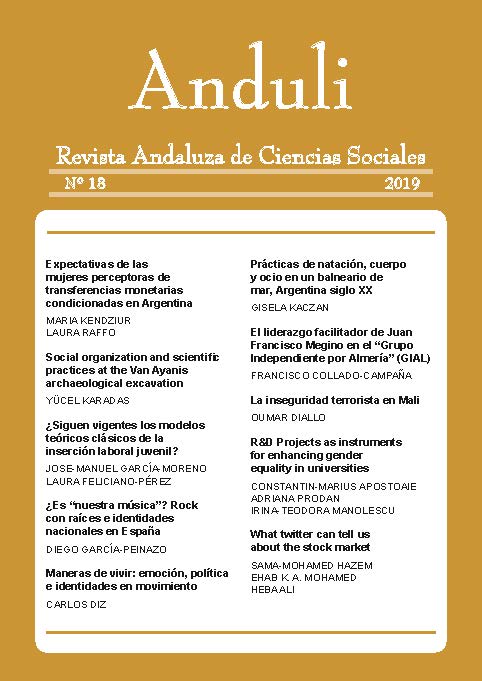Social organization and scientific practices at the Van Ayanis Archaeological Excavation
DOI :
https://doi.org/10.12795/anduli.2019.i18.02Mots-clés :
sociology of science, hierarchy, social organization, consensus, theory, theatrical rituals, archaeological excavationRésumé
Archeological excavation in the Ayanis settlement of the Urartu civilization, which is in today's Van district of Turkey, is one of the longest-lasting excavations in Turkey. Therefore, it is indicative of excavation practices of Turkey’s academy of archeology. This study focuses on the Ayanis excavation and analyzes the social organization of the excavation team, relationships amongthe team members, and the way they analyze their objects of study. The study also addresses how relationships at the excavation site transfer to the academy, and how relationships in the academy are affected. This study, which is an applied sociological research project focusing on archeological practices, aims to deduce simple theoretical abstractions from the experiences of the excavation team, which behaves as a narrow-scale social group. The research applies grounded theory, which is suitable for studying small groups. As such, simple abstract concepts are inferred in the light of the in-depth observation of and interviews with the participants of the excavation.
Téléchargements
Références
Arsebük, G. 2003. Yeni Arkeoloji’den Türkiye’de eleştiriye: Güven Arsebük ile söyleşi. Interview by: O. Erdur, G. Duru in “Arkeoloji: Niye? Nasıl? Ne İçin?” (Ed. Erdur, O.; Duru, G.) Istanbul.
Bourdieu, P. 2013. Bilimin Toplumsal Kullanımları- Bilimsel Alanın Klinik Sosyolojisi İçin, Heretik, Ankara.
Bourdieu, 2016. Devlet Üzerine- Collége de France Dersleri (1989-1992), İletişim, Istanbul.
Dyson, S.L. 2007. Antik Mermerler Amerika Kıyılarında- Birleşik Devletlerde Klasik Arkeoloji, Anahtar Kitaplar. Istanbul.
Erdur, O. 2003. “Bilginin Değeri Sorunsalı ve Türkiye’de Arkeolojinin Koşul ve Olasılıkları Üzerine” Arkeoloji: Niye? Nasıl? Ne İçin? (Ed. Erdur, O.; Duru, G.) Istanbul.
Karadaş, Y.; Demir, T. 2013. “Türkiye’de 1930-1970 Arası Arkeoloji Paradigmasının Bilim Sosyolojisi Açısından İncelenmesi” İnsanbilim Dergisi. 2/2:1-16.
Layder, D. 2013. Sosyolojik Araştırma Pratiği- Teori ve Sosyal Araştırmanın İlişkilendirilmesi. Heretik, Ankara.
Merton, R. 2010. “Bilimin Normatif Yapısı” Bilim Sosyolojisi İncelemeleri- Temel Yaklaşımlar, Kavramlar, Tartışmalar(Ed. Balkız, B. Öğütle, et al.) Ankara: 165-79.
Neuman, W.L. 2010. Toplumsal Araştırma Yöntemleri Nitel ve Nicel Yaklaşımlar. Yayın Odası, Istanbul.
Robson, C. 2015. Bilimsel Araştırma Yöntemleri- Gerçek Dünya Araştırması, Anı Yayınları, Ankara.
Sağlamtemir, H. 2001. Urartu Krallığı’nın Ekonomik Yapısı, Unpublished Ph.D. Dissertation, Ege University, SBE, İzmir.
Sancar, S. 2014. İdeolojinin Serüveni: Yanlış Bilinç ve Hegemonyadan Söyleme, İmge Yayınları. Ankara.
Scott, D. Morrison, M. 2016. Eğitim Araştırmasında Temel Fikirler ve Kavramlar. Sentez Yayınları. Bursa.
Stone, E. 2001. “The Outer Town at Ayanis: 1997-2001” Anatolian Iron Ages 5- Proceedings of the Fifth Anatolian Iron Ages Colloquium Held at Van, 6-10 August 2001 (Ed. A. Çilingiroğlu, G. Darbyshire) British Institute at Ankara: 187-193.
Stone, E. & Zimansky, P. 2003. “The Urartian Transformation in the Outer Town of Ayanis” Archaeology in the Borderland: Investigations in the Cauacasus and Beyond, (Ed. A.Smith and K. Rubinson) Los Angeles: Cotsen Institute: 213-228.
Veit, U. 2011. “Toward a Historical Sociology of German Archaeology” Comparative Archaelogies- a Sociological View of the Science of the Past (Ed. L. Lozny) Springer: 53-78.
Yıldırım, Y. 2015. “Türk İslam Arkeolojisi- Kısıtlar ve Fırsatlar” TÜBA- KED. 13/ 37-50.
Téléchargements
Publié-e
Comment citer
Numéro
Rubrique
Licence
Las ediciones impresa y electrónica de esta Revista son editadas por el Editorial Universidad de Sevilla, siendo necesario citar la procedencia en cualquier reproducción parcial o total.
Salvo indicación contraria, todos los contenidos de la edición electrónica se distribuyen bajo una licencia de uso y distribución “Creative Commons Atribución-NoComercial-SinDerivar 4.0 Internacional” ![]() Puede consultar desde aquí la versión informativa y el texto legal de la licencia. Esta circunstancia ha de hacerse constar expresamente de esta forma cuando sea necesario.
Puede consultar desde aquí la versión informativa y el texto legal de la licencia. Esta circunstancia ha de hacerse constar expresamente de esta forma cuando sea necesario.
Los autores/as que publiquen en esta revista aceptan las siguientes condiciones:
- Los autores/as conservan los derechos de autor y ceden a la revista el derecho de la primera publicación, con el trabajo registrado con la licencia de atribución de Creative Commons, que permite a terceros utilizar lo publicado siempre que mencionen la autoría del trabajo y a la primera publicación en esta revista.
- Los autores/as pueden realizar otros acuerdos contractuales independientes y adicionales para la distribución no exclusiva de la versión del artículo publicado en esta revista (p. ej., incluirlo en un repositorio institucional o publicarlo en un libro) siempre que indiquen claramente que el trabajo se publicó por primera vez en esta revista.
- Se permite y recomienda a los autores/as a publicar su trabajo en Internet (por ejemplo en páginas institucionales o personales) antes y durante el proceso de revisión y publicación, ya que puede conducir a intercambios productivos y a una mayor y más rápida difusión del trabajo publicado (vea The Effect of Open Access).





